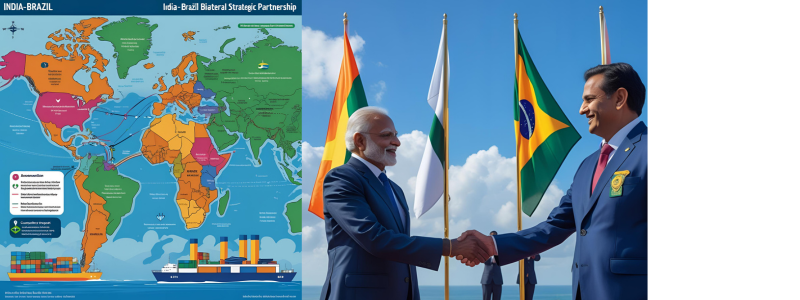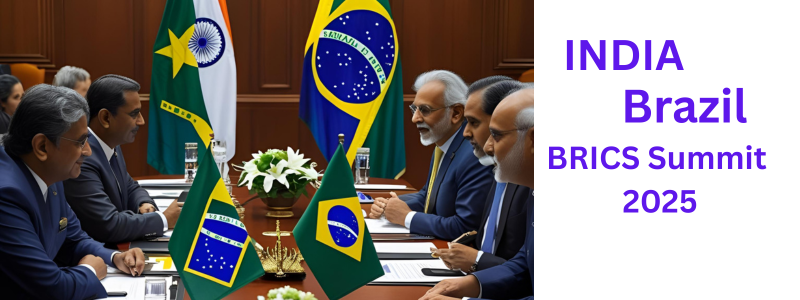Introduction
Prime Minister Narendra Modi is attending the BRICS Summit 2025 in Rio de Janeiro, Brazil, marking one of the most notable diplomatic visits by an Indian Prime Minister in recent times. This summit is significant not only for India’s foreign policy goals but also for the future of international cooperation among emerging economies.
The BRICS Summit brings together the five major emerging national economies: Brazil, Russia, India, China, and South Africa. These nations represent over 40% of the world population and hold considerable influence in global economics and politics. The summit is a platform where the member countries discuss mutual interests, economic collaboration, global security, sustainable development, and much more.
This year, PM Modi’s presence at the summit has drawn global attention, especially because it is one of the rare high-level Indian visits to Brazil in decades. His participation reflects India’s growing role as a global leader and a trusted partner in multilateral forums.
Table of Contents
Importance of BRICS for India
India’s participation in BRICS has always been a priority in its foreign policy. Here’s why BRICS is crucial for India: Modi BRICS Summit 2025 underscores India’s commitment to strengthening multilateral relations among emerging economics.
1. Economic Cooperation:
BRICS countries collaborate on trade, investment, and financial matters. It helps India explore new markets and reduce dependency on Western institutions.
2. Strategic Partnership:

BRICS allows India to work with like-minded countries on global issues such as terrorism, climate change, and digital innovation.
3. Multipolar World Order:
India believes in a multipolar world where no single country dominates. BRICS supports this vision by promoting cooperation among developing nations.
4. Global Governance Reform:
India uses the BRICS platform to demand reforms in institutions like the United Nations, World Bank, and IMF to make them more inclusive. During the Modi BRICS Summit 2025 address, the Prime Minister emphasized sustainable development, inclusive growth, and global south cooperation.
5. People-to-People Contact:
Through cultural exchanges, academic partnerships, and business meets, BRICS helps India build deeper ties with member countries.
Why This Visit is Historic
PM Modi’s current visit to Brazil is being described as historic for multiple reasons:
It is one of the first Indian Prime Ministerial visits to Brazil after many years. It comes at a time when India is actively engaging with Latin America to enhance trade and strategic ties. The visit signals India’s commitment to South-South cooperation—a term used to describe collaboration among developing nations.
Modi’s visit is seen as an effort to diversify India’s diplomatic and economic engagements beyond its traditional allies in Asia, the Middle East, and the West.
Key Discussions at the BRICS Summit 2025
Several critical topics are being discussed during the BRICS Summit this year. These include:
Global Economic Recovery
Post-pandemic, many developing countries are still struggling with slow economic growth. BRICS leaders are discussing ways to promote trade, attract investments, and support innovation. India is pushing for policies that support small businesses and digital startups.
From economic cooperation to digital innovation , the Modi BRICS Summit 2025 agenda covered wide-ranging issues.
Climate Change and Green Energy
Climate change is a global concern, and BRICS nations are among the largest contributors to carbon emissions. At the summit, PM Modi emphasized India’s progress in renewable energy, particularly solar power. He invited BRICS countries to collaborate on clean energy technologies and sustainability goals.The Modi BRICS Summit 2025 visit to Brazil marks a historic movement in India’s foreign diplomacy and strategic outreach.
BRICS Currency Proposal
One of the bold proposals at the summit is to create a BRICS-specific currency that could reduce reliance on the US dollar for international trade. India has welcomed the discussion but suggested more study and coordination before implement such a step.
The Modi BRICS Summit 2025 also included sideline meetings with key wold leaders fostering stronger intenational ties.
Cybersecurity and Artificial Intelligence
PM Modi proposed the creation of a “BRICS Digital Alliance”—a platform where member countries can collaborate on cybersecurity, AI research, and digital infrastructure. This is important as digital security becomes a major issue for all modern economies.
Education, Health, and Cultural Exchange
India is also advocating for greater cooperation in healthcare, education, and cultural exchange. Proposals include joint research programs, student exchange scholarships, and easier visa policies for professionals and tourists. one of the highlights of the Modi BRICS Summit 2025 will be the bilateral dialogue with Brazil aimed at boosting trade and defense collaboration.
India-Brazil Bilateral Talks

On the sidelines of the summit, PM Modi also held meetings with Brazilian President Luiz Inácio Lula da Silva. Here are the main highlights:
Agriculture: India and Brazil agreed to increase cooperation in agricultural technology and trade. Brazil is a leader in agri-innovation, and India sees potential for knowledge-sharing.
Defense: The two countries discussed expanding defense cooperation, including joint training programs and defense manufacturing.
Clean Energy: Both leaders agreed to collaborate on clean energy projects, particularly ethanol and biofuels, where Brazil has expertise.
Education and Culture: They announced the launch of a cultural exchange program and new scholarships for Indian and Brazilian students.
This bilateral engagement is expected to strengthen ties not only between India and Brazil but also between India and the broader Latin American region.
Global Response and Media Coverage
PM Modi’s visit and India’s active participation at the BRICS Summit have been widely covered by international media. Analysts have praised India’s leadership role and its constructive proposals during the summit.
Global economic observers are watching closely how India, Brazil, and other BRICS countries position themselves on critical issues like trade, inflation, AI, and sustainability. India’s approach of inclusive growth and sustainable development has been welcomed.
Challenges Ahead
While the summit brings many opportunities, there are challenges as well:
With a strong agenda on climate action and economic equity, the the Modi BRICS Summit 2025 speech captured international attention.
Geopolitical Tensions: With members like China and Russia, navigating differing political interests within BRICS can be tricky.
Coverage of the Modi BRICS Summit 2025 has sparked global media attention, highlighting India’s growing geopolitical relevance.
Economic Gaps: The economic conditions and priorities of BRICS countries vary widely, which makes coordination difficult.
Implementation: Proposals made at summits often take time to turn into reality due to bureaucratic or financial hurdles.
The Modi BRICS Summit 2025 engagement reflects India’s proactive role in shaping a multi polar world order.
India, however, remains committed to working through these challenges and building strong partnerships based on trust and shared goals.
Conclusion
The BRICS Summit 2025 is a turning point for India’s global diplomacy. PM Modi’s visit to Brazil is not just symbolic—it’s strategic. It signals India’s readiness to lead, collaborate, and innovate on the world stage.
From proposing a digital alliance to supporting a fairer global economy, India’s role at the summit shows its long-term vision. The focus is clear: sustainable growth, technological progress, inclusive partnerships, and a voice for the developing world.
As the summit concludes, the real work begins—turning ideas into action and ensuring that the cooperation fostered during these meetings leads to real-world impact.
Stay connected with us for daily current affairs, global summit analysis, and India’s international relations. This moment in history may shape the decade ahead.

